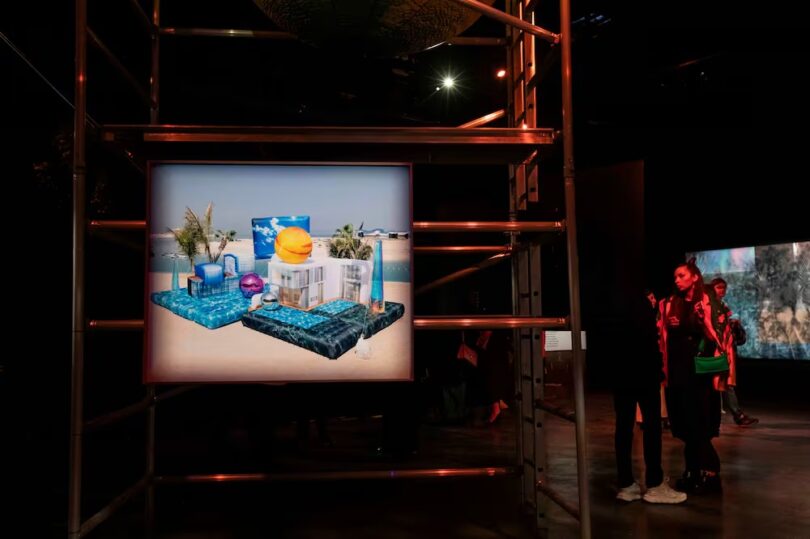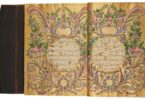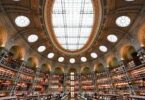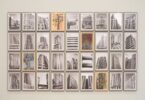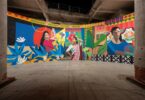Razmig Bedirian
Modern urban environments may have much in common with Bedouin traditions.
The thought first struck Filippo Minelli as he travelled to Dubai in 2021. Another wave of the Covid-19 pandemic had taken hold during his visit, and the Italian artist found he was unable to return to Europe for another six months due to travel restrictions.
The situation, however, turned out to be a creatively fruitful one.
“It was a wonderful, inspiring time,” Minelli tells The National.
As he took his time exploring Dubai, witnessing its rapid tendency towards change, he reflected on post-globalist architectural trends. The contemporary world is shaped by rapid cultural exchange and mobility.
There is, Minelli says, less of an attachment with permanent architecture. The ideal city in today’s context, he says, is not so concerned with historical affections. Adaptibility and utility, rather, are the priority.
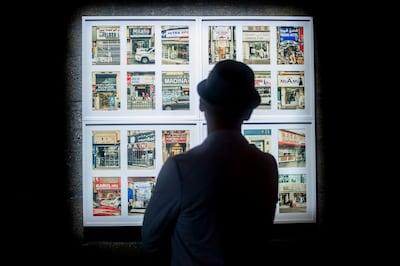
Minelli’s solo exhibition at Inloco Storage in Dubai’s Al Khayat Art Avenue is an examination of the collective notions of what constitutes a perfect city, and how that idea has developed in recent times.
His exhibition is special as it brings indoors an artist who is known for creating sprawling works for public spaces. The show marks the space’s first show and hints at its mission to come.
The Idealised City, which runs until May 1, takes its title from an idea by 15th century Italian author Leon Batista Alberti.
Alberti’s concept of the ideal city suggested that urban spaces should be conceived with architecture that caters to each segment of the population, reflecting on their historical and cultural identities.
The Idealised City considers how this idea resonates in a world dictated by mutability and multiculturalism. The exhibition, in a way, rebukes Alberti’s concept and shows that it perhaps no longer applies today.
It also underscores how there is an older notion from the Middle East that is perhaps more harmonious with today’s attitudes.
In his theory of the Virtuous City (Al Madinat Al Fadilah), the 9th century philosopher Abu Nasr Muhammad Al Farabi proposed that the ideal urban environment was one that was founded on communal effort and malleability.
Al Farabi’s utopic city was more fluid and prone to change than the one envisioned by Alberti. It was also more reflective with Bedouin attitudes, particularly with nomadic perceptions.
A space or structure had less of a sentimental value than it did a utilitarian one. It was a necessary attitude to have in the harsh environment of the desert, where resources were scarce and fluctuations in weather meant that it was vital to be able to pack up and move on to another location if the situation demanded it.
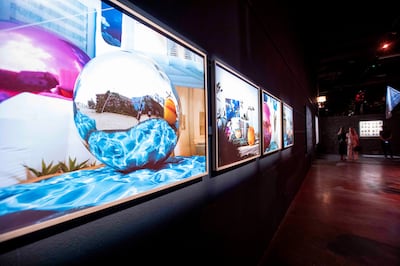
Minelli says he found a permutation of this permutation in how urban environments are shaped today.
This is true around the world, where it seems there is a lack of historical concerns to how new spaces are being built. Instead, software-wrought designs rendered in cookie-cutter fashion have taken hold.
The proliferation of such structures may make it seem like they put local cultures at stake, but Minelli says there is another perspective to consider.
“If you go to Miami, Singapore, Sao Paulo, there are these trends that on one side, local identities are disappearing, but it’s a process I grew up with, so I would say it’s a new kind of identity that is globalised,” he says.
“I don’t know if it’s a good thing or a bad thing.”
One of the artist’s photo series in the exhibition reflects this. The photographs, taken in Deira, show buildings and shopfronts named after cities in the US as well as from across Europe, Africa and Asia.
There are clothing shops with the Eiffel Tower in their banner, restaurants bearing the name Kabul, machinery shops called Osaka, and a general trading store that has been branded as Busan.
The works are a gleeful take on the fact that these shopfronts can be located virtually anywhere in the world, and how multicultural identities form Dubai’s social fabric.
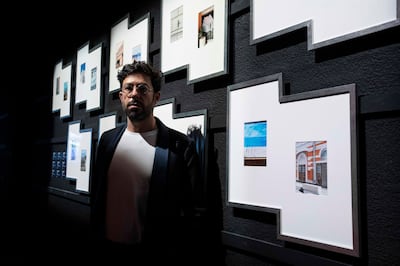
Minelli says he has been fascinated with these post-globalist urban trends for some time but didn’t really consider that they may have a Bedouin connection until his visit to Dubai.
While the city, he says, strives to reflect on its cultural identity and history with many projects, there are nevertheless vast neighbourhoods that are instead honed with a contemporary mindset.
Minelli says he was also gripped by the city’s propensity for change, and how roads were constantly reworked, and buildings torn down to make room for new ones or remodelled to better suit the area’s needs.
“This is my interpretation, but the ability they have here to build something and then change it a few years after if it’s not necessary any more or if there’s a different need, I don’t know if it comes from a Bedouin tradition of being nomads, of this ability to change depending on the need, [maybe] it comes from this very ancestral method,” he says.
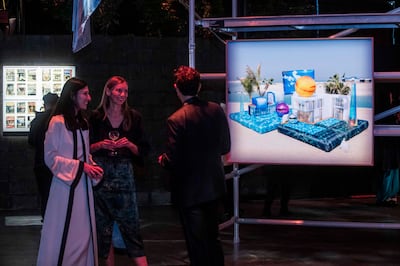
The exhibition’s eponymous work pays homage to this. The Idealised City was conceived as an intervention at World Islands, and segments of the work as well as photographs of the original project are displayed at the exhibition.
The project comprises stock images of a villa that has brought to life in an inflatable material form.
The work uses rendered designs that are perhaps absent of any one cultural form, while also evoking the notion that it can be deflated and reinstalled in a new place with ease.
“They are stock images that I downloaded, and then readopted on a 3D model that then has been delivered to a company to produce the actual craft,” Minelli says.
The Idealised City perhaps best encapsulates the exhibition’s overall theme, but it also shows Minelli’s art thrives in the rift between the digital and the tangible.
The divide may be perceived as vast, but as the Italian artist shows, the seams between the two worlds is becoming increasingly harder to demarcate.
It is also along this slimming cusp that the artist best explores the interplay between the real and the idealised.
The digital realm, after all, can be a melange of romanticised forms.
By juxtaposing computer-generated images with physical materials, Minelli exposes how collective notions of the ideal are manifested in the digital space, and how these notions then reflect back on the physical world.
There are several works that touch on this, including UV fabrics featuring computer-generated clouds that are interposed with patterns derived from real leaves, or panels of marble veins, which again began as stock images before being reproduced using inked thumbprints in their final form.
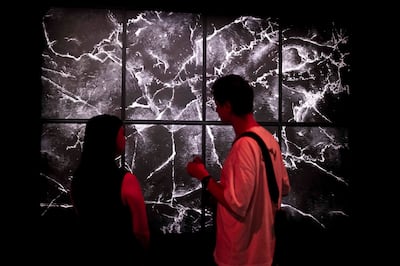
“I started not from real marble, but from stock images that I repainted using my own fingerprints,” he says.
“They’re related to my own personal experience and growing up with this very tangible stone. I come from Italy, where marble is a big thing.
“Botticino, one of the villages next to where I was born, is where they sourced the marble for St Peter’s Basilica.”
Another photographic series, meanwhile, shows how computer-generated images of bygone architecture are being used to drape construction sites across Europe – again marking a somewhat seamless merger between the digital and physical worlds.
Other drapes, meanwhile, suggest how the building will look like after the construction’s completion.
“It is not the real building, but it’s the representation of the building,” Minelli says.
The photographs are presented as diptychs.
“You have two photos and they are from two different nations,” he says. “I wanted to play on this kind of disappearance of local specificities and how idealised aesthetics crosses borders since globalisation started.”
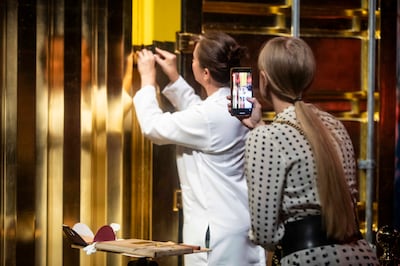
At the centre of the space is a large shipping container adorned with gold leaf. The element is a permanent highlight of Inloco Storage. The container features several sliding walls that project outwards to display artworks.
For The Idealised City, the storage is being used to display Silent Shapes, a series Minelli began in 2009. The photographs show snowy and lush landscapes.
Although each is different in their own way, the photographs share one aspect, the presence of coloured smoke.
“All the landscapes that you see have a history of conflict, they are all beautiful but they all have a history of conflict,” he says.
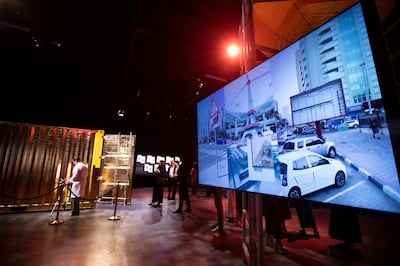
The Idealised City is the inaugural exhibition of Inloco Storage. Xenia Zobova, cultural producer at Inloco, says the new space will be in line with the art group’s aim of challenging the conventions of art exhibitions.
Inloco Storage, she says, will be dedicated to bring artists renowned for their outdoor works within an indoor space, and the golden container is a symbolic representation of that.
“The Inloco Open Storage concept delves into the realms of the urban culture, which is temporary by nature,” Zobova says.
“We were trying to keep this temporality inside the space of a warehouse, to bring the outdoor indoor.
“An industrial container is the most ubiquitous object you can find in like almost everywhere globally.
“Bringing it inside and exhibiting street artists and urban artists within the container is keeping this idea of temporality of street art practices.”

